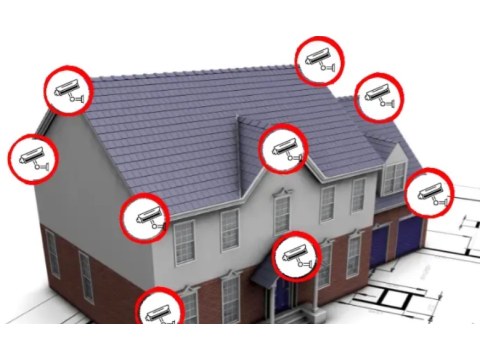Optimal Placement of Surveillance Cameras
The strategic placement of surveillance cameras ensures maximum coverage and effective monitoring, minimizing the number of devices required while maximizing security.
Key Parameters for Camera Placement
When positioning cameras, consider:
- Height of Installation: Balances coverage and accessibility.
- Angle of View: Depends on the camera’s focal length and lens type.
- Location: Minimizes blind spots and exposure to potential tampering.
For outdoor setups, prioritize locations that prevent vandalism or damage, such as placing cameras high enough to be out of reach.
Placing Outdoor Cameras
Outdoor cameras face unique challenges such as weather and vandalism. Key tips:
Height and Accessibility
- Install cameras at a height of 8–10 feet to balance coverage and detail.
- Use vandal-proof enclosures to protect against damage.
Avoid Blind Spots
- Check for static blind spots like trees or walls and dynamic obstructions such as vehicles.
- Overlap fields of view for comprehensive coverage.
Specific Use Cases
- Entrance Monitoring: Position cameras at 1.5–2 feet above the door to capture facial details, clothing, and behavior.
- Perimeter Surveillance: Mount on fences or dedicated poles to ensure continuous monitoring.
Placing IP Cameras
IP cameras have unique requirements due to their network-based design.
Proximity to Network Equipment
- Maintain a maximum distance of 100 meters from the nearest network switch or router.
- Use weatherproof enclosures for outdoor network components.
Centralized Equipment Setup
- For multiple cameras, adopt a star configuration with a central switch for efficient connectivity.
Electromagnetic Interference (EMI)
- Avoid placement near high-power electrical sources.
- Use shielded cables and ensure proper grounding to mitigate interference.
Placing Indoor Cameras
Indoor cameras focus on coverage and design aesthetics.
Choosing the Right Height
- Place cameras at eye level for entrance areas to capture facial details.
- For room-wide coverage, position at corners or ceilings with a wide-angle lens.
Aesthetic Integration
- Dome cameras are ideal for most interiors due to their compact and unobtrusive design.
- Use recessed mounts or camouflage options to maintain interior aesthetics.
General Tips for Camera Placement
- Avoid Direct Light: Prevent glare from windows or lights.
- Optimize Viewing Angles: Use cameras with adjustable mounts for flexibility.
- Test Placement: Before final installation, check for blind spots or obstructions.
Conclusion: Proper placement of surveillance cameras is crucial to achieving optimal security and efficiency. Whether for indoor, outdoor, or IP systems, adhering to these best practices ensures your system performs at its best.

